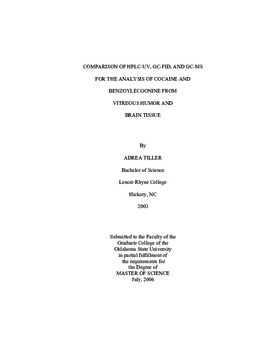| dc.contributor.author | Tiller, Adrea | |
| dc.date.accessioned | 2014-03-14T21:53:42Z | |
| dc.date.available | 2014-03-14T21:53:42Z | |
| dc.date.issued | 2006-07-01 | |
| dc.identifier.uri | https://hdl.handle.net/11244/8100 | |
| dc.description.abstract | A rate at which cocaine metabolizes postmortem has not yet been established. Factors such as postmortem environment, metabolism, and redistribution have given rise to complications in extrapolating antemortem drug levels from postmortem findings. The purpose of this study is to look at in vivo cocaine metabolism in vitreous humor and brain tissue of male Sprague-Dawley rats 4-6 months of age employing the use of three analytical methods. HPLC detected cocaine in vitreous humor and brain and benzoylecgonine in the brain. Either benzoylecgonine levels in vitreous humor fell below the level of detection or low enzymatic activity caused incomplete metabolism of cocaine. GC-MS detected cocaine and benzoylecgonine in the vitreous humor and brain. The level of detection for GC-MS was four times more sensitive than HPLC. Future studies to establish a rate of cocaine metabolism postmortem should employ the use of GC-MS for analysis of cocaine metabolism in the vitreous humor. | |
| dc.format | application/pdf | |
| dc.language | en_US | |
| dc.publisher | Oklahoma State University | |
| dc.rights | Copyright is held by the author who has granted the Oklahoma State University Library the non-exclusive right to share this material in its institutional repository. Contact Digital Library Services at lib-dls@okstate.edu or 405-744-9161 for the permission policy on the use, reproduction or distribution of this material. | |
| dc.title | Comparison of Hplc-uv, Gc-fid, and Gc-ms for the Analysis of Cocaine and Benzoylecgonine from Vitreous Humor and Brain Tissue | |
| dc.type | text | |
| osu.filename | Tiller_okstate_0664M_1948.pdf | |
| osu.college | Arts and Sciences | |
| osu.accesstype | Open Access | |
| dc.description.department | Chemistry Department | |
| dc.type.genre | Thesis | |
